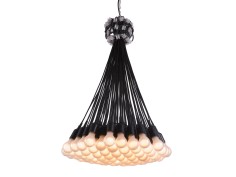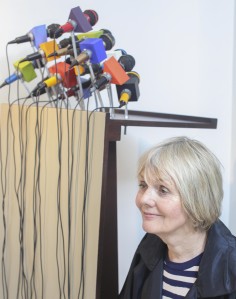
Innovative Dutch design company Droog opens a Hong Kong store
Innovative Dutch design company Droogis opening a store here to showcase eccentric creations, writes Christopher De Wolf

Renny Ramakers is excited to show off Droog's new branch in Hong Kong. "You must see the living room," she says, bounding up to the top floor of the three-storey building on Square Street in Sheung Wan.

"And over here, look at the toilet," she adds, gesturing at glass walls obscured by a metallic veneer. "It changes depending on where you stand."
It's eclectic and eccentric - the qualities for which Droog is known. Founded in 1993 in Amsterdam by Ramakers, a design historian, and Gijs Bakker, an industrial designer, the brand is at once conceptual and commercial.
In the early 1990s, it made its mark by showcasing irreverent pieces suchas Tejo Remy's Chest of Drawers, a jumble of second-hand drawers, and Rody Graumans' 85 Lamps chandelier, a bouquet of ordinary incandescent bulbs.

What distinguishes Droog from other brands is its down-to-earth sensibility and dry sense of humour (from which the brand gets its name - droog means "dry" in Dutch). "It makes design accessible, it makes the message accessible, it breaks the daily routine and it makes people happy," she says.
She points at a pair of wine glasses suspended from the bottom of a shelf, a small mallet fixed between them. "Normally, if you have a doorbell, you push the button and you don't see what happens," she says, engaging a small button which prompts a mallet to swing gently between them. Ding dong.
"When people see this and hear the sound, they smile," Ramakers says. An abacus-like bench covered in marbles has the same effect. "When people sit on it and slide over the marbles, they start laughing," she says, walking over to another object infused with humour.
This time, it is a fish tank with a miniature banquet table inside. "There are fish tanks inside Chinese restaurants, so we put a Chinese restaurant inside a fish tank.
"It's transparent," she continues. "People can see that it is just simple marbles on the bench, or simple glasses in the doorbell. That makes a great experience. I see people at all layers of society recognise this. It's high design but it's not high design in a traditional way that makes things very posh."
The best place to see this philosophy in action is at Droog's 7,000 sq ft flagship in Amsterdam, the Hôtel Droog, which includes a retail shop, cafe, gallery, garden and a single bedroom that can be rented by visitors.
"People were already spending a long time in our store so we gave them the option to stay even longer," Ramakers jokes. The entire sprawling complex is united by the mismatched, whimsical style that has become the brand's calling card.
"Ten years ago in Milan, we rented a very dirty, ugly hotel, zero stars, and we asked designers to bring one piece, one experience for each room. If you look at our café in Amsterdam, there's some high-end lighting but the chairs are just old things painted white.
It’s not high design in the traditional way that makes things posh
"And everyone thinks, 'Wow, what a beautiful space.' We can do this because we're not creating a total interior. Of course, we have our aesthetics, but we can express our aesthetics in a flexible way."
Ramakers says she thinks total design - in which the designer is responsible for every detail of a space, right down to the fixtures and furniture - is "too demanding of the user".
She prefers design that allows space for improvisation, space that can evolve over time, and she is particularly excited by the potential new directions the brand could take in Asia.

"My wish is to create all kinds of hospitality experiences that are different everywhere. When we do something, we do it with our own attitude, our twist, but we try to respect the place where we are doing it."
It remains to be seen how Droog adapts to Hong Kong - and how Hong Kong adapts to Droog. In 2009, after opening a shop in New York, Bakker left the company in a huff, accusing Ramakers of selling out. "[New York] involves millions of euros and pushes Droog's original philosophy to the background," he said in a public statement.
"I refuse to let the Droog direction be decided by commercial considerations." The New York shop closed suddenly in 2010 and was replaced by an outpost in Las Vegas, which closed in 2012.
Ramakers says Droog's commercial endeavours remain balanced by non-profit work such as a project to redesign solar panels, or an exhibition at the Bi-City Biennale of Urbanism\Architecture in Shenzhen. She revels in the effect Droog has had on the design scene.
"When I gave a tour of the exhibition in Shenzhen, a stranger took over and began explaining everything in Chinese," she says. "I asked him how he knew so much and he said he had studied it in university."
Michael Leung, a former Droog employee who now teaches at the Hong Kong Polytechnic University's School of Design, says Droog's presence here could have a positive effect on the design scene.
"Because the level of design thinking is still lower in Hong Kong than in the West, I think a lot of my students will benefit from being exposed to Droog's way of doing things," he says.